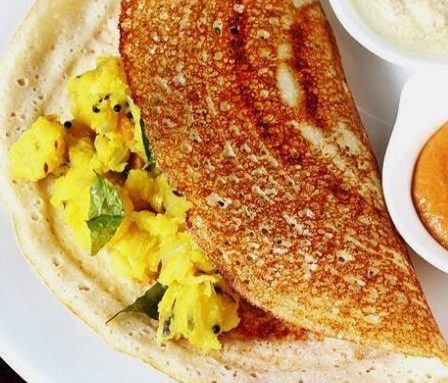Dosa is a savory crepe-like food from southern India that is made primarily of rice and lentils. There are many different fillings and varieties in batters that are used to make types of dosa. Please be sure that you’re consuming a dosa that does not contain wheat, maida (all purpose flour), semolina, or untested oats. The different types of dosa each originate in a specific area of India. Uttapam is a type of dosa that is thicker than the traditional crispy kind, but it uses the same basic batter. Appam uses a coconut milk and rice flour blend, and includes a thicker middle portion that sometimes includes a sunny side-up egg. Appam creates a kind of bowl shape, due to the crispy edges and thicker middle. Dosa is often served for breakfast.
The texture of a standard dosa is thin and crispy, with a slight tang from the fermentation of the batter. This thin crispy shell will encase the heartier portion of the meal, which might be spiced potatoes and chutney, if you’re having a traditional masala dosa. There are different types of chutney that are served with each style of dosa. Indian pickles and lentil soup are also commonly served with dosa. The meal has carbs from the rice, as well as protein from the lentils. Because the batter is airy and fermented, this is a relatively healthy and well-balanced meal.
To make dosa, first you’ll decide on the variety you’d like to explore. The first post I’ll link below offers a guide to make four different types. The standard ingredients to make dosa are rice and urad dal (black lentils, a relative of mung beans) that have been soaked overnight in water. Chana dal is sometimes added to give the crepes a more golden color.These are then blended to form a batter and this is fermented until bubbly. Once fermentation is complete, thin crepes are formed and fried with some ghee or oil until crispy.
